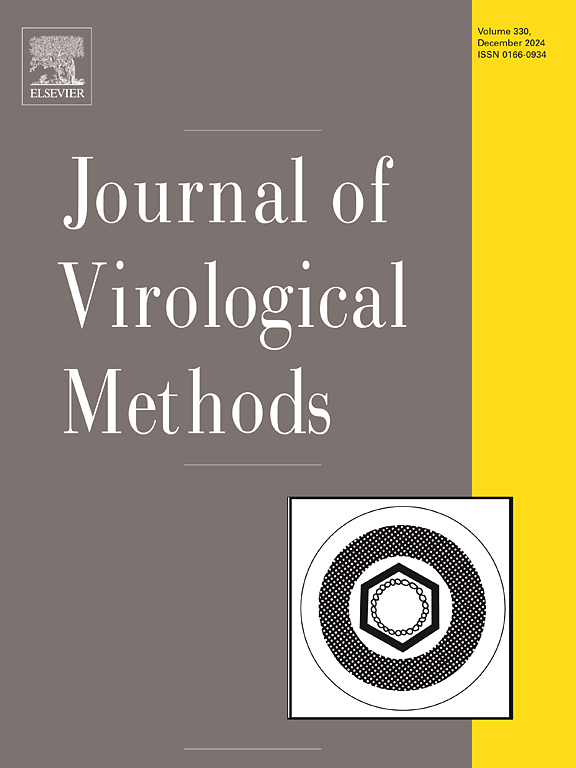Genomic characterization of the Coxsackievirus A24 variant in the Acute Hemorrhagic Conjunctivitis outbreak (2023) in Islamabad, Pakistan through metagenomic next generation sequencing
IF 1.6
4区 医学
Q3 BIOCHEMICAL RESEARCH METHODS
引用次数: 0
Abstract
Pakistan experienced a significant outbreak of Acute Hemorrhagic Conjunctivitis (AHC) in 2023. To identify the cause, in the absence of targeted diagnostic tests, the National Institute of Health, Islamabad, studied 15 conjunctivitis patients from Islamabad in September 2023. Metagenomic Next Generation Sequencing (mNGS) was performed on 10 samples collected within 48 h of symptom onset. The human Coxsackievirus A24 variant (CV-A24v), genotype IV, was detected in three samples. Phylogenetic analysis showed ∼99 % similarity with recent strains from China and 94 % similarity with the 2015 France outbreak. Mutation analysis revealed mostly non-synonymous substitutions, particularly in the VP1 region (n = 14), and differences in 2 C and 3D regions of nonstructural proteins. Comparison with 2005 Pakistan outbreak sequences showed divergence in the VP1 region, with two distinct mutations ("L16I" and "L25H"), with L16I being a rare mutation observed only in strain from China and India in 2023. Structural modeling of VP1 proteins indicated conformational differences between the 2023 and 2005 strains, suggesting potential impacts on viral infectivity and immune escape. These findings indicate the reemergence of CV-A24v in Pakistan and highlight the importance of adaptable diagnostic strategies to respond to emerging infectious threats.
通过下一代元基因组测序分析巴基斯坦伊斯兰堡急性出血性结膜炎暴发(2023)中柯萨奇病毒A24变异的基因组特征
2023年,巴基斯坦爆发了严重的急性出血性结膜炎(AHC)。为了确定原因,在缺乏针对性诊断测试的情况下,伊斯兰堡国家卫生研究所于2023年9月对伊斯兰堡的15名结膜炎患者进行了研究。对症状出现后48 h内采集的10份样本进行宏基因组下一代测序(mNGS)。在3份样本中检测到人柯萨奇病毒A24变异(CV-A24v),基因型为IV型。系统发育分析显示,该病毒与近期来自中国的菌株相似度为~ 99 %,与2015年法国疫情相似度为94 %。突变分析显示大部分非同义替换,特别是在VP1区域(n = 14),以及非结构蛋白的2 C和3D区域的差异。与2005年巴基斯坦暴发序列的比较显示VP1区域存在差异,有两种不同的突变(“L16I”和“L25H”),其中L16I是一种罕见的突变,仅在2023年来自中国和印度的毒株中观察到。VP1蛋白的结构建模显示2023和2005菌株之间的构象差异,表明对病毒感染和免疫逃逸的潜在影响。这些发现表明CV-A24v在巴基斯坦再次出现,并突出了适应性诊断策略对应对新出现的传染性威胁的重要性。
本文章由计算机程序翻译,如有差异,请以英文原文为准。
求助全文
约1分钟内获得全文
求助全文
来源期刊
CiteScore
5.80
自引率
0.00%
发文量
209
审稿时长
41 days
期刊介绍:
The Journal of Virological Methods focuses on original, high quality research papers that describe novel and comprehensively tested methods which enhance human, animal, plant, bacterial or environmental virology and prions research and discovery.
The methods may include, but not limited to, the study of:
Viral components and morphology-
Virus isolation, propagation and development of viral vectors-
Viral pathogenesis, oncogenesis, vaccines and antivirals-
Virus replication, host-pathogen interactions and responses-
Virus transmission, prevention, control and treatment-
Viral metagenomics and virome-
Virus ecology, adaption and evolution-
Applied virology such as nanotechnology-
Viral diagnosis with novelty and comprehensive evaluation.
We seek articles, systematic reviews, meta-analyses and laboratory protocols that include comprehensive technical details with statistical confirmations that provide validations against current best practice, international standards or quality assurance programs and which advance knowledge in virology leading to improved medical, veterinary or agricultural practices and management.

 求助内容:
求助内容: 应助结果提醒方式:
应助结果提醒方式:


